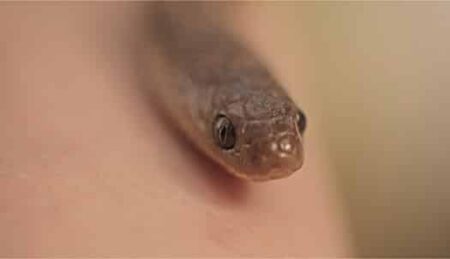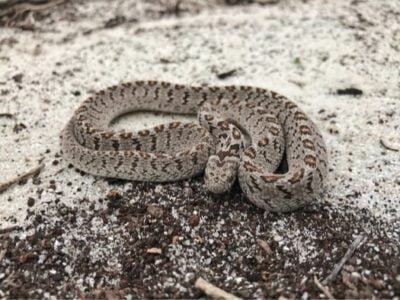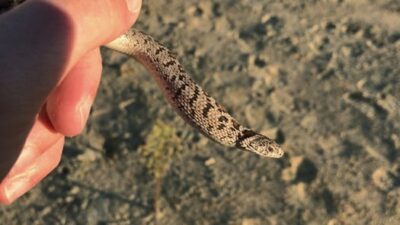The egg-eating snake survives on a diet consisting of small bird eggs. It is the nearest that you’ll get to a vegetarian pet snake. If you dislike the idea of feeding your snake a diet of rodents, this could be the ideal pet snake.
Egg-eating snakes are easy to care for and docile once they trust you. They’re non-venomous and toothless, so they can’t bite you. Sourcing eggs to feed your snake can be difficult because chicken eggs are too large. This means that you’ll need to give your female egg-eater Coturnix quail eggs and brown Button quail eggs to the males.
We’re going to look at the pros and cons of egg-eating snakes as pets. This includes the two different types available, how they eat their food, and how to care for egg-eating snakes in captivity.
Egg-Eating Snakes As Pets
The Indian egg-eating snake is much rarer than the African egg-eating snake. It’s not usually kept as a pet. So, if you’re considering getting an egg-eater, the African egg-eating snake is really your only option.
Though they’re still wild animals, some experienced snake owners do keep African egg-eaters as pets. You won’t find them in pet stores, but you can find African egg-eaters for sale at exotic pet sites.
The species that you’ll find may vary, but the most common species is the common (or rhombic) egg-eater, Dasypeltis scabra.
African egg-eating snakes are calm, docile creatures. Like all wild snakes, they may be flighty and nervous, to begin with. However, with regular handling, they come to realize that you’re not a threat. They aren’t aggressive and will rarely strike as they don’t have any teeth.
What Are Egg-Eating Snakes?
Egg-eaters are small-to-medium-sized snakes in the family Colubridae. There are two main types of egg-eating snakes:
| Indian Egg-Eating Snakes: | This is a rare species found in India, Nepal, and Bangladesh. They are around 31 inches long as adults. They are a shiny brown-black with whitish flecks and a single cream-colored stripe running from head to tail. Their scientific name is Elachistodon westermanni. |
| African Egg-Eating Snakes: | There are 16 recognized species found across Africa. The most common species (the common egg-eating snake) are greyish-brown with white bellies. They have dark markings along their backs and keeled scales. Females can grow to 30 inches, but males are smaller. Their scientific name is Dasypeltis scabra. |
Egg-Eating Snake Care Guide
Despite their exoticism, egg-eating snakes are easy to take care of as pets. Their natural environment is dry, so they don’t require much humidity.
Like all exotic snakes, they will require temperatures above what you’d have your home’s thermostat set to, but that’s easily remedied by a heat pad or under-cage heater.
And of course, feeding is one of the most appealing parts of owning this type of snake, especially if you’re put off by feeding snakes live prey.
Setting Up the Vivarium
Choose a plastic or wooden tank that’s slightly longer than your pet snake. This will ensure that it has enough room to maneuver, but isn’t so large that your snake will feel vulnerable due to the size of its new home.
Only keep one egg-eating snake in an enclosure. Snakes aren’t social creatures, but these snakes don’t fight because they lack teeth. However, they can pass on illness, disease, and parasites. They can also breed.

Humidity
They are not demanding when it comes to moisture and humidity. Try to keep the humidity around 40-60%. You can achieve this by adding a water bowl and/or humidifier to the snake’s enclosure.
Provide a moist hide, filled with sphagnum moss, when your egg eater is shedding its skin. This will help to prevent problem sheds.
Temperature
Snakes are cold-blooded, so they need a warm environment to thermoregulate. One end should be warmer than the other, which is known as a thermal gradient.
The cool end of their enclosure should be around 73 degrees Fahrenheit, with the warm end at about 85F. Provide a hide at either end, so that the snake can alternate sides to moderate its body temperature.
Substrate (Bedding)
Egg-eating snakes do not burrow, so you don’t need a thick layer of substrate. Aspen shavings are a good choice, but there are others.
Regularly remove feces and urine (as required) and replace the substrate entirely at least once a month to keep your snake healthy.
Accessories And Enrichment
In the wild, egg eaters climb trees and rocks to get to birds’ nests. Enrich the enclosure by providing fake branches, rocks, and leaves for them to climb on. This is, of course, in addition to a hide and water bowl.
What To Feed An Egg-Eating Snake
Choose a bird’s egg that is the same width as your snake’s middle. For fully grown female egg-eaters, Coturnix quail eggs are often a good choice. These are the kind of quail eggs that you can find at your local grocery store. They’re white to cream in color and blotched with brown.
If your egg-eater is a male (or a juvenile), however, Coturnix eggs may be too large. Small, brown Button quail eggs are more suitable. They can be harder to find. Some owners of egg-eating snakes raise button quail or finches, to supply eggs for their snake.

How Do Egg Eating Snakes Eat Eggs?
They’ve evolved over the years to feed exclusively on eggs, and because of this, they’ve developed a way of doing it. This is as follows:
- Locate a source of eggs. They are good at climbing trees and rocky outcrops to locate birds’ nests. They can navigate through branches and over rough terrain to sniff out their food source.
- Check for freshness. These snakes can detect an egg’s freshness just by smelling it. They can’t digest older eggs that have fully or partially developed bird fetuses inside. According to Zoology, their digestive systems are designed to digest the liquids inside undeveloped eggs.
- Swallow the egg whole. Egg-eaters can stretch their mouths and necks to accommodate eggs that are up to 10 times the size of their heads. It’s a slow process where they swallow the eggs whole.
- Break the egg. They have bony spikes (spurs) on the inside of the spine. Once the egg is swallowed, they will contort their bodies and use the spikes to crush the egg. They then consume the white and yolk.
- Regurgitate the shell. They have no use for the empty eggshell and can’t excrete it, so they will regurgitate it.
How Often Do You Need to Feed Your Snake?
- Egg-eating snakes need to eat an egg every 7 days when they’re young.
- Adult egg eaters may only need to be fed every 14 days.
Note: Make sure that you remove any uneaten eggs that have been lying about in the closure for more than a couple of weeks.
How To Feed Egg-Eating Snakes?
Move your snake into a separate, empty container. This is to prevent your snake from swallowing any substrate from its vivarium. Consuming the bedding can lead to impaction (constipation in snakes.)
However, if you choose to place the egg inside a false nest or bowl with no substrate inside, you’re safe feeding them inside the vivarium.
Do Egg-Eating Snakes Bite?
Do egg-eating snakes have teeth? They don’t eat live animals. For that reason, egg-eating snakes have no teeth at all. So, even if an egg-eater tried to bite you, you’d feel no pain whatsoever.
Are Egg Eating Snakes Venomous?
Egg-eating snakes are non-venomous. Here’ some information on how to tell if a snake is venomous. As they subsist on a diet of bird eggs, there’s no need for them to produce venom.

How Do Egg-Eating Snakes Defend Themselves?
Certain species, such as Dasypeltis scabra, mimic saw-scaled vipers, their venomous lookalikes.
They rub their keeled scales together to produce the sizzling sound that saw-scaled vipers make. This warns predators to stay away.
How Long Do Egg Eating Snakes Live?
In the wild, African egg-eating snakes live for an average of just 5 years. However, wild snakes could be eaten by predators, get diseases, or die when trying to eat an egg that’s too large.
According to the Animal Ageing and Longevity Database, common egg-eating snakes can live for up to 22 years in captivity. However, 10-15 years is the average life expectancy for a pet egg-eating snake.
Do Egg Eating Snakes Make Good Pets?
Advantages of egg-eating snakes as pets:
- They aren’t venomous snakes
- They won’t bite you because they have no teeth
- You feed them eggs, not rodents (mice and rats)
- Stay relatively small at around 2-3 feet as adults
- They don’t require as much humidity or heat as other exotic snakes
Disadvantages of egg-eating snakes as pets:
- Egg eaters start off quite small, which makes feeding difficult. Male egg-eating snakes remain small as adults. Coturnix quail eggs, which are often the only ones available, can be too large.
- The temperament of egg-eating snakes can be variable. Some are calm and docile, while others become stressed out by handling. They’ll usually adjust once they realize that you’re not a threat.
- They don’t live as long as other types of snakes. For example, while an egg-eater may live to 15, it’s common for ball pythons to reach 30.
As long as you’re sure you can source their food, an egg-eater could be a sound choice for a pet. Consider the pros and cons, and decide whether this fascinating snake would be right for you. If not, here are some other good beginner pet snakes for you to consider.

